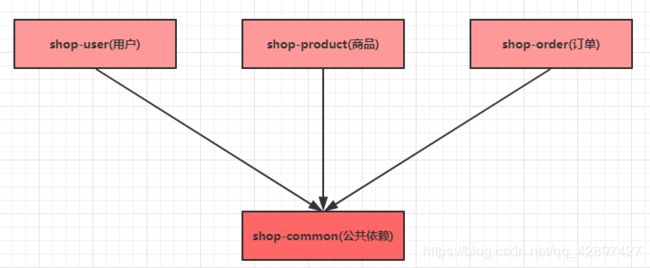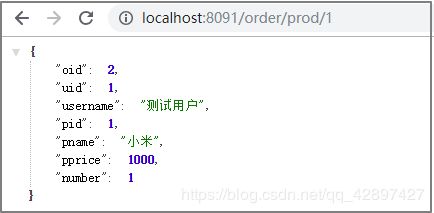第二章 : 微服务环境搭建
我们承接上一篇开始 第一章 :微服务的架构介绍发展 SpringCloudAlibaba技术栈的学习
我们本次是使用的电商项目中的商品、订单、用户为案例进行讲解。
2.1 案例准备
2.1.1 技术选型
-
maven:3.6.0
-
数据库:MySQL 5.7
-
持久层: SpingData Jpa
-
其他: SpringCloud Alibaba 技术栈
2.1.2 模块设计
下面是项目端口号说明及项目结构
springcloud-alibaba父工程shop-common公共模块【实体类】shop-user用户微服务 【端口: 807x】shop-product商品微服务 【端口: 808x】shop-order订单微服务 【端口: 809x】
2.1.3 微服务调用
在微服务架构中,最常见的场景就是微服务之间的相互调用。我们以电商系统中常见的用户下单为例来演示微服务的调用:客户向订单微服务发起一个下单的请求,在进行保存订单之前需要调用商品微服务查询商品的信息。
我们一般把服务的主动调用方称为服务消费者,把服务的被调用方称为服务提供者。
 在这种场景下,订单微服务就是一个服务消费者, 商品微服务就是一个服务提供者。
在这种场景下,订单微服务就是一个服务消费者, 商品微服务就是一个服务提供者。
2.2 创建父工程
创建一个maven工程,然后在pom.xml文件中添加下面内容
<project xmlns="http://maven.apache.org/POM/4.0.0"
xmlns:xsi="http://www.w3.org/2001/XMLSchema-instance"
xsi:schemaLocation="http://maven.apache.org/POM/4.0.0 http://maven.apache.org/xsd/maven-4.0.0.xsd">
<modelVersion>4.0.0modelVersion>
<groupId>com.spiritmark.cloudgroupId>
<artifactId>springcloud-alibabaartifactId>
<packaging>pompackaging>
<version>1.0-SNAPSHOTversion>
<parent>
<groupId>org.springframework.bootgroupId>
<artifactId>spring-boot-starter-parentartifactId>
<version>2.1.3.RELEASEversion>
parent>
<properties>
<java.version>1.8java.version>
<project.build.sourceEncoding>UTF-8project.build.sourceEncoding>
<project.reporting.outputEncoding>UTF-8project.reporting.outputEncoding>
<spring-cloud.version>Greenwich.RELEASEspring-cloud.version>
<spring-cloud-alibaba.version>2.1.0.RELEASEspring-cloud-alibaba.version>
properties>
<dependencyManagement>
<dependencies>
<dependency>
<groupId>org.springframework.cloudgroupId>
<artifactId>spring-cloud-dependenciesartifactId>
<version>${spring-cloud.version}version>
<type>pomtype>
<scope>importscope>
dependency>
<dependency>
<groupId>com.alibaba.cloudgroupId>
<artifactId>spring-cloud-alibaba-dependenciesartifactId>
<version>${spring-cloud-alibaba.version}version>
<type>pomtype>
<scope>importscope>
dependency>
dependencies>
dependencyManagement>
project>
截自 2020 年 1月 7日 版本对应:
2.3 创建基础模块
1 创建shop-common 模块,在pom.xml中添加依赖
<project xmlns="http://maven.apache.org/POM/4.0.0"
xmlns:xsi="http://www.w3.org/2001/XMLSchema-instance"
xsi:schemaLocation="http://maven.apache.org/POM/4.0.0 http://maven.apache.org/xsd/maven-4.0.0.xsd">
<parent>
<artifactId>springcloud-alibabaartifactId>
<groupId>com.spiritmark.cloudgroupId>
<version>1.0-SNAPSHOTversion>
parent>
<modelVersion>4.0.0modelVersion>
<artifactId>shop-commonartifactId>
<dependencies>
<dependency>
<groupId>org.springframework.bootgroupId>
<artifactId>spring-boot-starter-data-jpaartifactId>
dependency>
<dependency>
<groupId>org.projectlombokgroupId>
<artifactId>lombokartifactId>
dependency>
<dependency>
<groupId>com.alibabagroupId>
<artifactId>fastjsonartifactId>
<version>1.2.56version>
dependency>
<dependency>
<groupId>mysqlgroupId>
<artifactId>mysql-connector-javaartifactId>
<version>5.1.6version>
dependency>
dependencies>
project>
2 创建实体类
用户类
import lombok.Data;
import javax.persistence.Entity;
import javax.persistence.GeneratedValue;
import javax.persistence.GenerationType;
import javax.persistence.Id;
//用户
@Entity(name = "shop_user")//实体类跟数据表的对应
@Data//不再去写set和get方法
public class User {
@Id
@GeneratedValue(strategy = GenerationType.IDENTITY)//数据库自增
private Integer uid;//主键
private String username;//用户名
private String password;//密码
private String telephone;//手机号
}
商品类
import lombok.Data;
import javax.persistence.Entity;
import javax.persistence.GeneratedValue;
import javax.persistence.GenerationType;
import javax.persistence.Id;
//商品
@Entity(name = "shop_product")
@Data
public class Product {
@Id
@GeneratedValue(strategy = GenerationType.IDENTITY)
private Integer pid;//主键
private String pname;//商品名称
private Double pprice;//商品价格
private Integer stock;//库存
}
订单类
import lombok.Data;
import javax.persistence.Entity;
import javax.persistence.GeneratedValue;
import javax.persistence.GenerationType;
import javax.persistence.Id;
//订单
@Entity(name = "shop_order")
@Data
public class Order {
@Id
@GeneratedValue(strategy = GenerationType.IDENTITY)
private Long oid;//订单id
//用户
private Integer uid;//用户id
private String username;//用户名
//商品
private Integer pid;//商品id
private String pname;//商品名称
private Double pprice;//商品单价
//数量
private Integer number;//购买数量
}
2.4 创建用户微服务
步骤:
- 1 创建模块 导入依赖
- 2 创建SpringBoot主类
- 3 加入配置文件
- 4 创建必要的接口和实现类(controller service dao)
新建一个shop-user 模块,然后进行下面操作
<project xmlns="http://maven.apache.org/POM/4.0.0"
xmlns:xsi="http://www.w3.org/2001/XMLSchema-instance"
xsi:schemaLocation="http://maven.apache.org/POM/4.0.0 http://maven.apache.org/xsd/maven-4.0.0.xsd">
<parent>
<artifactId>springcloud-alibabaartifactId>
<groupId>com.spiritmark.cloudgroupId>
<version>1.0-SNAPSHOTversion>
parent>
<modelVersion>4.0.0modelVersion>
<artifactId>shop-userartifactId>
<dependencies>
<dependency>
<groupId>com.spiritmark.cloudgroupId>
<artifactId>shop-commonartifactId>
<version>1.0-SNAPSHOTversion>
dependency>
dependencies>
project>
2 编写主类
@SpringBootApplication
@EnableDiscoveryClient
public class UserApplication {
public static void main(String[] args) {
SpringApplication.run(UserApplication.class, args);
}
}
3. 编写配置文件
server:
port: 8071
spring:
application:
name: service-user
datasource:
driver-class-name: com.mysql.jdbc.Driver
url: jdbc:mysql:///shop?serverTimezone=UTC&useUnicode=true&characterEncoding=utf-8&useSSL=true
username: root
password: root
jpa:
properties:
hibernate:
hbm2ddl:
auto: update
dialect: org.hibernate.dialect.MySQL5InnoDBDialect
2.5 创建商品微服务
1 创建一个名为shop_product 的模块,并添加springboot依赖
<project xmlns="http://maven.apache.org/POM/4.0.0"
xmlns:xsi="http://www.w3.org/2001/XMLSchema-instance"
xsi:schemaLocation="http://maven.apache.org/POM/4.0.0 http://maven.apache.org/xsd/maven-4.0.0.xsd">
<parent>
<artifactId>springcloud-alibabaartifactId>
<groupId>com.spiritmark.cloudgroupId>
<version>1.0-SNAPSHOTversion>
parent>
<modelVersion>4.0.0modelVersion>
<artifactId>shop-productartifactId>
<dependencies>
<dependency>
<groupId>org.springframework.bootgroupId>
<artifactId>spring-boot-starter-webartifactId>
dependency>
<dependency>
<groupId>com.spiritmark.cloudgroupId>
<artifactId>shop-commonartifactId>
<version>1.0-SNAPSHOTversion>
dependency>
dependencies>
project>
2 创建工程的主类
@SpringBootApplication
public class ProductApplication {
public static void main(String[] args) {
SpringApplication.run(ProductApplication.class, args);
}
}
3 创建配置文件application.yml
server:
port: 8081
spring:
application:
name: service-product
datasource:
driver-class-name: com.mysql.jdbc.Driver
url: jdbc:mysql:///shop?serverTimezone=UTC&useUnicode=true&characterEncoding=utf-8&useSSL=true
username: root
password: root
jpa:
properties:
hibernate:
hbm2ddl:
auto: update
dialect: org.hibernate.dialect.MySQL5InnoDBDialect
4 创建ProductDao接口
public interface ProductDao extends JpaRepository<Product,Integer> {
}
5 创建ProductService接口和实现类
@Service
public class ProductServiceImpl implements ProductService {
@Autowired
private ProductDao productDao;
@Override
public Product findByPid(Integer pid) {
return productDao.findById(pid).get();
}
}
6 创建Controller
import lombok.extern.slf4j.Slf4j;
import org.springframework.beans.factory.annotation.Autowired;
import org.springframework.web.bind.annotation.PathVariable;
import org.springframework.web.bind.annotation.RequestMapping;
import org.springframework.web.bind.annotation.RequestParam;
import org.springframework.web.bind.annotation.RestController;
@RestController
@Slf4j
public class ProductController {
@Autowired
private ProductService productService;
//商品信息查询
@RequestMapping("/product/{pid}")
public Product product(@PathVariable("pid") Integer pid) {
log.info("接下来要进行{}号商品信息的查询", pid);
Product product = productService.findByPid(pid);
return product;
}
7 启动工程,等到数据库表创建完毕之后,加入测试数据
INSERT INTO shop_product VALUE (NULL, '小米', '1000', '5000');
INSERT INTO shop_product VALUE (NULL, '华为', '2000', '5000');
INSERT INTO shop_product VALUE (NULL, '苹果', '3000', '5000');
INSERT INTO shop_product VALUE (NULL, 'OPPO', '4000', '5000');
8 通过浏览器访问服务
2.6 创建订单微服务
1 创建一个名为shop-order 的模块,并添加springboot依赖
<project xmlns="http://maven.apache.org/POM/4.0.0"
xmlns:xsi="http://www.w3.org/2001/XMLSchema-instance"
xsi:schemaLocation="http://maven.apache.org/POM/4.0.0 http://maven.apache.org/xsd/maven-4.0.0.xsd">
<parent>
<artifactId>springcloud-alibabaartifactId>
<groupId>com.spiritmark.cloudgroupId>
<version>1.0-SNAPSHOTversion>
parent>
<modelVersion>4.0.0modelVersion>
<artifactId>shop-orderartifactId>
<dependencies>
<dependency>
<groupId>org.springframework.bootgroupId>
<artifactId>spring-boot-starter-webartifactId>
dependency>
<dependency>
<groupId>com.spiritmark.cloudgroupId>
<artifactId>shop-commonartifactId>
<version>1.0-SNAPSHOTversion>
dependency>
dependencies>
project>
2 创建工程的主类
@SpringBootApplication
public class OrderApplication {
public static void main(String[] args) {
SpringApplication.run(OrderApplication.class, args);
}
}
3 创建配置文件application.yml
server:
port: 8091
spring:
application:
name: service-order
datasource:
driver-class-name: com.mysql.jdbc.Driver
url: jdbc:mysql:///shop?serverTimezone=UTC&useUnicode=true&characterEncoding=utf-8&useSSL=true
username: root
password: root
jpa:
properties:
hibernate:
hbm2ddl:
auto: update
dialect: org.hibernate.dialect.MySQL5InnoDBDialect
4 创建OrderDao接口
public interface OrderDao extends JpaRepository<Order,Long> {
}
5 创建OrderService接口和实现类
@Service
public class OrderServiceImpl implements OrderService {
@Autowired
private OrderDao orderDao;
@Override
public void save(Order order) {
orderDao.save(order);
}
}
6 创建RestTemplate
@SpringBootApplication
public class OrderApplication {
public static void main(String[] args) {
SpringApplication.run(OrderApplication.class, args);
}
@Bean
public RestTemplate getRestTemplate() {
return new RestTemplate();
}
}
7 创建Controller
@RestController
@Slf4j
public class OrderController {
@Autowired
private RestTemplate restTemplate;
@Autowired
private OrderService orderService;
//准备买1件商品
@GetMapping("/order/prod/{pid}")
public Order order(@PathVariable("pid") Integer pid) {
log.info(">>客户下单,这时候要调用商品微服务查询商品信息");
//通过restTemplate调用商品微服务
Product product = restTemplate.getForObject(
"http://localhost:8081/product/" + pid, Product.class);
//通过restTemplate调用商品微服务
Product product = restTemplate.getForObject(
"http://localhost:8081/product/" + pid, Product.class);
log.info(">>商品信息,查询结果:" + JSON.toJSONString(product));
Order order = new Order();
order.setUid(1);
order.setUsername("测试用户");
order.setPid(product.getPid());
order.setPname(product.getPname());
order.setPprice(product.getPprice());
order.setNumber(1);
orderService.save(order);
return order;
}
7 启动工程,通过浏览器访问服务进行测试
本章只是搭建基本环境,并不过多讲解



